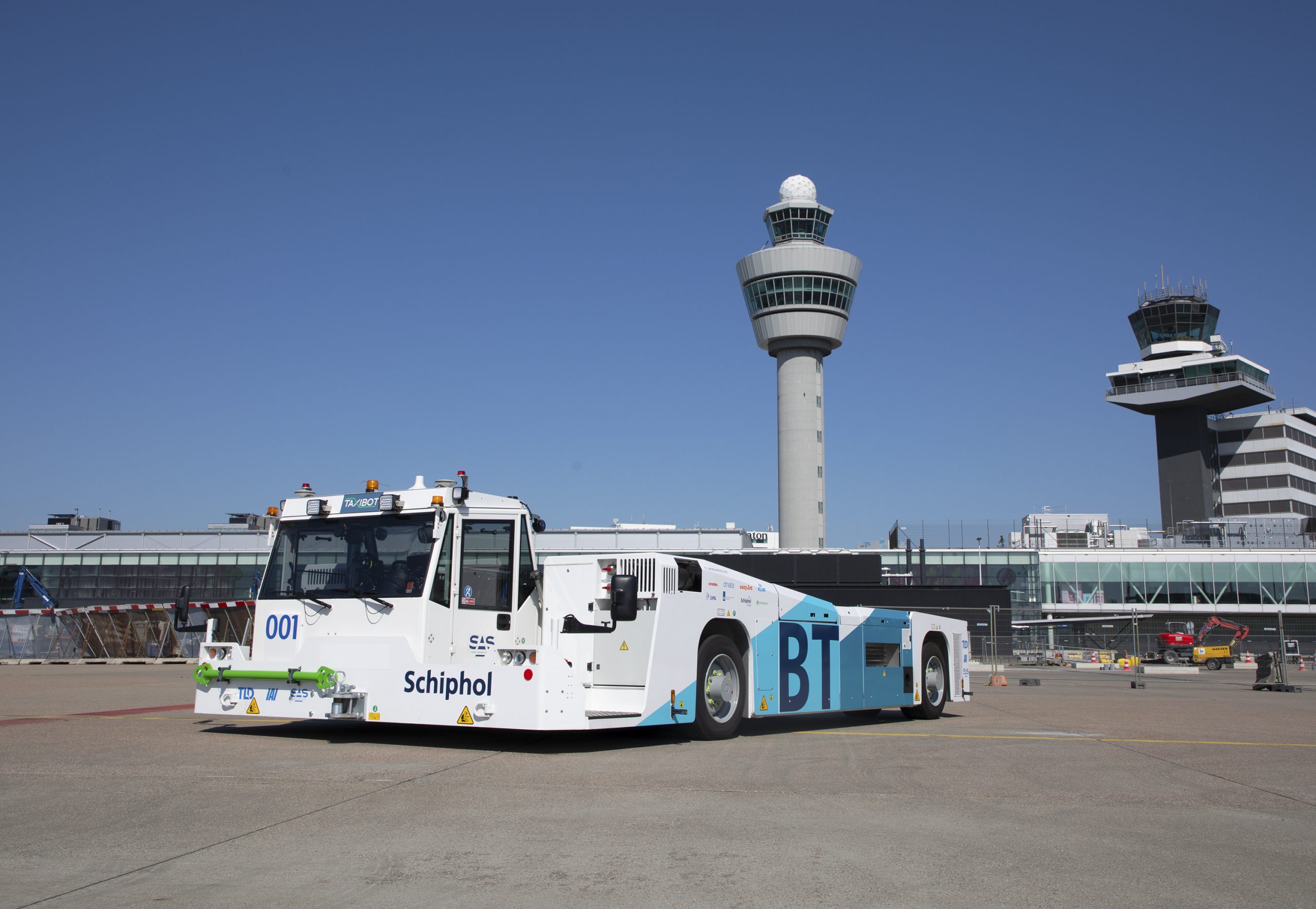Sustainable taxiing at Amsterdam Airport Schiphol
By Wilma van Dijk (Schiphol Amsterdam Airport)
12 May 2022
Shares
Amsterdam Airport Schiphol explores a European aviation first, with the deployment of sustainable Taxibots to continue the airports journey towards the reduction of aircraft and flight emissions. Wilma van Dijk, Director Safety, Security & Environment at Schiphol Group, explains more.
Taxiing a plane to the Polderbaan Runway (18R / 36L) at Amsterdam Airport Schiphol (AMS) will soon be significantly more sustainable. In 2022, Schiphol is buying two TaxiBots, which can be used to tow specific types of aircraft to and from the runway, allowing pilots to keep engines switched off for most of the taxiing time. This will lead to a significant reduction in emissions of (ultra)fine particles, nitrogen, and CO2.
2022 is a crucial year for sustainability in the aviation sector, as we plan to accelerate and fast-track measures to reduce emissions and improve local air quality for the climate, our employees, and local residents. This way, you will still be able to fly and discover the world, but in a responsible and sustainable way – a way in which we do not place extra pressure on our planet, but add value to it instead. One example of how we plan to achieve this is, is by implementing sustainable taxiing.
Taxiing with fewer emissions
The TaxiBot is a special towing vehicle that takes a plane from the gate to the runway, or from the runway to the gate. It’s different from other towing vehicles, as the TaxiBot can taxi a fully loaded aircraft at close to normal taxiing speeds. During taxiing, the TaxiBot is controlled by the aircraft pilot – not the truck driver in the vehicle itself. The driver only connects the TaxiBot to the aircraft and carries out the pushback (the process of pushing the plane backwards from the gate). The pilot takes control as soon as the taxiing procedure starts.
2022 is a crucial year for sustainability in the aviation sector, as we plan to accelerate and fast-track measures to reduce emissions and improve local air quality”
Furthermore, pilots do not need to run aircraft engines while taxiing with the TaxiBot, as it tows the plane itself. That means the engines can remain switched off for longer, which saves fuel and in turn leads to fewer CO2, NOx, and (ultra)fine particle emissions. The TaxiBot produces significantly fewer emissions than an aircraft engine. An earlier pilot study at Schiphol showed that around 50 per cent less fuel is needed for sustainable taxiing. And, when it comes to taxiing to the Polderbaan runway – our most distant (and preferred) runway, fuel savings can reach up to 65 per cent.


Credit: Schiphol Group
Sustainable taxiing to the Polderbaan runway
In a few years, about a fifth of all flights are expected to taxi sustainably”
Various preparations are required before the TaxiBots can taxi to the Polderbaan as part of our upcoming live trials. For example, we need to add additional markings to the asphalt that allow pilots to stop the aircraft and Taxibot in the right place to carry out the (un)coupling procedures. Some of our service roads also need to be widened to enable the special vehicles to drive to, and from, the Polderbaan before, and after, sustainable taxiing has taken place, all without disrupting other traffic at the taxiways.
Standard procedure
Schiphol has drawn up a plan together with Air Traffic Control the Netherlands (LVNL), KLM, Transavia, Corendon Dutch Airlines, and ground handling companies dnata and KLM Ground Services, to ensure that sustainable taxiing will become standard procedure. Our first step is the deployment of these two special aircraft towing vehicles for a follow-up trial at Schiphol, in which TUI, Viggo, and Swissport will also participate. This demonstration is art of the European SESAR ALBATROSS project. The SESAR ALBATROSS consortium aims to develop and demonstrate more sustainable flight operations, applying multiple strategies and solutions to save fuel for each stage of a flight from gate to gate. If successful, the live trial will be the prelude to a standard procedure, with certain types of aircraft taxiing sustainably to, and from, the Polderbaan runway.
TAKE A READ:
Why airports should think like tech companies by Sjoerd Blüm
Fully automated system cargo terminal to open at Schiphol Airport
Amsterdam Airport Schiphol trials new electric ground equipment
Amsterdam Airport approves digital declarations to streamline cargo chain
Schiphol’s ambition is to be the most sustainable airport in the world. We aspire for our ground movements activities on, and around, our airport to be zero emission by 2030″
In the years to follow, the number of aircraft that can be brought to, and from, the Polderbaan in this way, will increase. In a few years, about a fifth of all flights are expected to taxi sustainably. The collaborating parties aim to gradually introduce sustainable taxiing on other runways from 2025 onwards, so that it will be standard procedure across Schiphol by 2030.
A first in European aviation
Schiphol’s ambition is to be the most sustainable airport in the world. We aspire for our ground movements activities on, and around, our airport to be zero emission by 2030. And we’re encouraging cleaner, quieter, and smarter flight. That is why we are the first European airport to invest in sustainable taxiing using the TaxiBot. There are currently a few TaxiBots in use at two airports in India, so progress is being made worldwide.
By investing in these kinds of sustainable innovations, we can ensure that travelling by air remains accessible for future generations too.
Biography


Until June 2020, Dijk was also responsible for cyber-security at the airport and the CISO of Schiphol Group.













